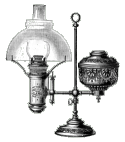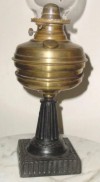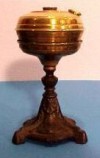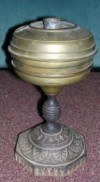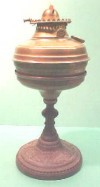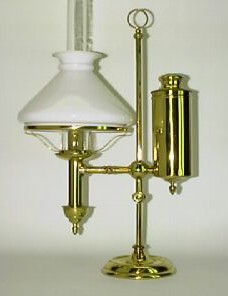 The Cleveland Non-Explosive Lamp Company Library Lamp with House's Argand Burner
The Cleveland Non-Explosive Lamp Company Library Lamp with House's Argand Burner
|
The Cleveland Non-Explosive Lamp Company was incorporated on February 19, 1868 with manufactory, showroom and business offices in Cleveland, Ohio. The original principals were T.T. Seelye, H.L. Hoffman, John Spalding, John M. Perkins, Mark W. House and Alfred Ewell.
1 William J. Gordon was a successful Cleveland businessman and according to the 1870-71 Cleveland City Directory, is listed as the proprietor of the company.
2 The company started at 87 Water Street. It later occupied four large floors of the Atwater Building at the corners of Superior and Merwin streets.
3 The Cleveland Non-Explosive Lamp Co. maintained a branch office at 42 Barclay Street in New York City throughout most, if not all, of it's existence. To view an image of an 1873 billhead
[click here].
There are fourteen patents associated with The Cleveland Non-Explosive Lamp Company. John M. Perkins and Mark Wiggins House would be key inventors with a dozen patents between them. William J. Gordon shared two patents with House. These patents span a period of time between March 14, 1865 and September 11, 1877. Some of these patents were assigned to The Cleveland Non-Explosive Lamp Company, others were not. See the
patent table below for details.
Once More a Word on Kerosene
 Last evening at Harwich, Mass., two little girls, of six and four years respectively, were left with a kerosene lamp burning in the chamber in which they had been put to bed. The house took fire and the children perished. They cannot tell their story, but all appearances indicate that fire originated in their room from an explosion. The mother of these children has become a maniac.
Last evening at Harwich, Mass., two little girls, of six and four years respectively, were left with a kerosene lamp burning in the chamber in which they had been put to bed. The house took fire and the children perished. They cannot tell their story, but all appearances indicate that fire originated in their room from an explosion. The mother of these children has become a maniac.
--N.Y. Tribune
|
|
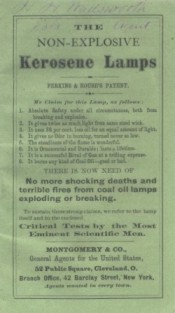 Original Advertising Pamphlet
Original Advertising Pamphlet
H.H. Wadsworth, Sole Agent
|
Like so many other products manufactured and produced during this era, Perkins and House's Non-Explosive lamps were all about safety. The
dangers of fire resulting from broken or exploding lamps was well documented. Injury and loss of life and property was a reality across the nation. Many had little, if any, insurance. A massive marketing campaign touting the claims of their lamps was undertaken. This early advertising pamphlet (left) claims "No more shocking deaths and terrible fires from coal oil lamps exploding or breaking." This pamphlet is sixteen pages packed full of testimonials from satisfied customers. It was published by Montgomery & Co., general agents for the United States located at 52 Public Square, Cleveland, Ohio. Hand written across the top is the name of H.H. Wadsworth, Sole Agent.
There was a wide selection of Perkins and House's lamps produced. They manufactured a handsome study or student lamp (shown above) and claimed that it provided one-third more light than any other lamp of similar style in the world! They made a number of hand lamps, in both bronzed tin and brass. Stand lamps were manufactured in a number of styles as well with a variety of bases - brass and cast iron. Founts were available to replace those on bracket lamps and
chandeliers.
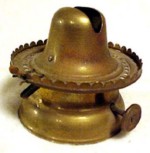 Miller Sun Hinge Skirted Burner
Miller Sun Hinge Skirted Burner
|
Many of these lamps were available with either the flat-wick burner or their Argand burner which they claimed "Will produce more light than any three common lamps in the market, and nearly double the light of any other argand burner (of the same size) in the world! The company also produced a patented safety filling can for storing and dispensing kerosene and other volatile fluids.
The lamps using the flat-wick burner must have been more successful or affordable than the argand burners and they are infinitely more common today. The argand burners are scarcely seen. The fimiliar Sun Hinge Skirt Burner found on most Perkins and House's lamps was manufactured by the
Edward Miller & Company. The 1881 Miller catalogue has a page
| Patent No. |
Patent Date |
Inventor |
| 36,680 |
Oct. 14, 1862 |
Alvin Taplin |
| 39,320 |
July 21, 1863 |
J.J. Marcy |
| 71,949 |
Dec. 10, 1867 |
G.E. Baldwin |
|
|
of non-explosive center draft lamps. It depicts a figural stem lamp with shade, the tin hand lamp and the brass hand lamp. The catalogue states: "We also have Shade Holders that will fit the cone of the Sun Hinge Burner, and the Cone Shades, allowing the Shade, Burner and Chimney to be thrown back in lighting." The Miller burners often contain one or more of the patents on the thumbwheel in the accompanying table. Others are marked E. MILLER & CO. / MADE IN USA. All the known flat-wick burners employed take a flanged or lip chimney. Some are held on by a thumb screw, others are secured by a spring-clip.
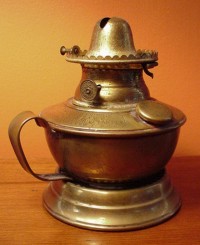 The Cleveland Non-Explosive Lamp Company's No. 5 Improved Brass Hand Lamp
The Cleveland Non-Explosive Lamp Company's No. 5 Improved Brass Hand Lamp
|
Most of The Cleveland Non-Explosive Lamp Company lamps are profusely marked. The shoulder of the fount of the lamp at right is marked PERKINS & HOUSE SAFETY LAMP / CLEV'D. NON-EXPLOSIVE LAMP CO. / CLEVELAND & NEW YORK and PAT'D DEC. 11. 1866 / NOV. 24. 1857 / NOV. 18. 1871. The fill cap is marked PAT. NOV. 24. 1857. The 1857 patent date relates to William Pratt's patent number 18,704 for non-explosive designs for a lamp fount and oil can, similar to principles that Perkins and House applied to their lamps and cans. The 1866 date is for Perkins and House's patent number 60,416. Interestingly, Alfred Ewell was noted as a witness to the patent. Patent number 121,521, granted to M.W. House, is dated December 5, 1871, but it is antedated to November 18, 1871, the third date noted.

Patents associated with the Cleveland Non-Explosive Lamp Company.
Covers the period between March 14, 1865 - Sept. 11, 1877 |
| 46819 |
60416 |
93117 |
76764 |
103334 |
112459 |
112460 |
121521 |
| 129728 |
132655 |
137306 |
141223 |
152493 |
194953 |
[ more? ] |
| D = Design Patent, RE = Reissue of an earlier Patent |
To view any of the above patents, enter the number in the box below and select Query USPTO Database. This will take you to the specific patent images on the U.S. Patent & Trademark Office Database. Learn more about the USPTO here.

- 1 Nolan, Marianne and Norman Jones, The Cleveland Non-Explosive Lamp Company: Perkins and House's Metallic Safety Lamps, The Rushlight, Volume 65, No. 4, December 1999, p. 2
- 2 ibid.
- 3 ibid

- The Cleveland Non-Explosive Lamp Co. , circa 1875 - photocopy of original catalog, 16 pp.
- Edward E. Miller & Co. Illustrated Catalog of Lamps And Cigar Lighters, 1881, 1976, Fairweather Antiques
- Miller, Richard C. and John F. Solverson, Student Lamps of the Victorian Era, 1992, Antique Publications
- Nolan, Marianne and Norman Jones, The Cleveland Non-Explosive Lamp Company: Perkins and House's Metallic Safety Lamps, The Rushlight, Volume 65, No. 4, December 1999
- The Non-Explosive Kerosene Lamps (Perkins & House), circa 1871 - original advertising pamphlet
- Thuro, Catherine M.V., Oil Lamps, The Kerosene Era in North America, 1976, Collector Book
- Thuro, Catherine M.V., Oil Lamps 3, 2001, Collector Books
 Search Cleveland Non-Explosive
Search Cleveland Non-Explosive 